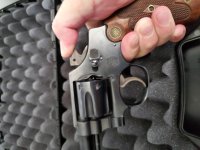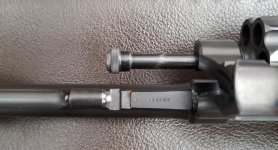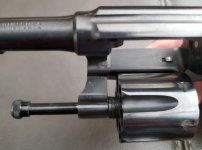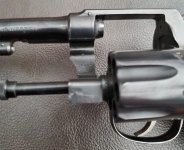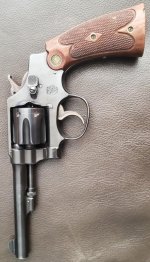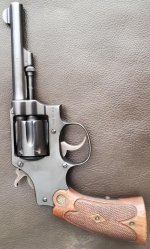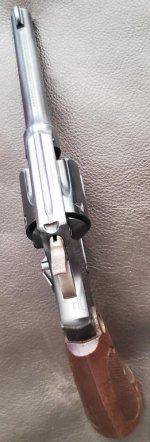Yes that's the exact correct hammer nose (firing pin).
And here's the correct hammer nose rivet (retaining hollow pin):
Smith & Wesson Model 38 Revolver Parts, Schematics | Numrich Gun Parts
To install:
I use the method where you clamp one center punch perfectly vertical, point up in a vice, cock the hammer and wedge it in cocked position with eraser, clumped cloth, etc. Insert the firing and the hollow rivet (pin). Helper holds the gun with hammer pin on the point of the clamped punch. Then use a second center punch and light hammer on the top side to flare the rivet; both sides will be flared at the same time. When done, the rivet MUST BE FLUSH with both sides of the hammer to keep from contacting/DENTING the sides of the hammer channel.
You have a ".32 Hand Ejector 3rd Model" made from 1917 to 1942. It's an 'I' frame size with a 4 1/4" barrel. I agree with the aforementioned likely shipping date estimates. Most likely shipped the last quarter of 1924 - first quarter of 1925.
It was re-introduced in ~1946 after the war and was designated the "Model 30" in 1957. At the beginning of 1961 it was changed by being built on the J frame, a slightly longer frame horizontally for a longer cylinder.
Versions are still made to this day.
Congrats, that's a sweetheart. And although the grips are not the originals, you'll find them superior for shooting than the original small round butt grips. A former owner knew what worked best.
The original grips were this style in Gutta Percha black rubber or checkered walnut w/o medallions:
Any standard off the shelf loads available today are fine for your .32. It has the heat treated cyl which began n 1920. Enjoy.

